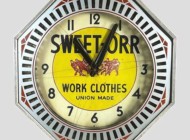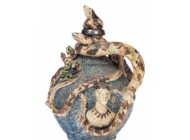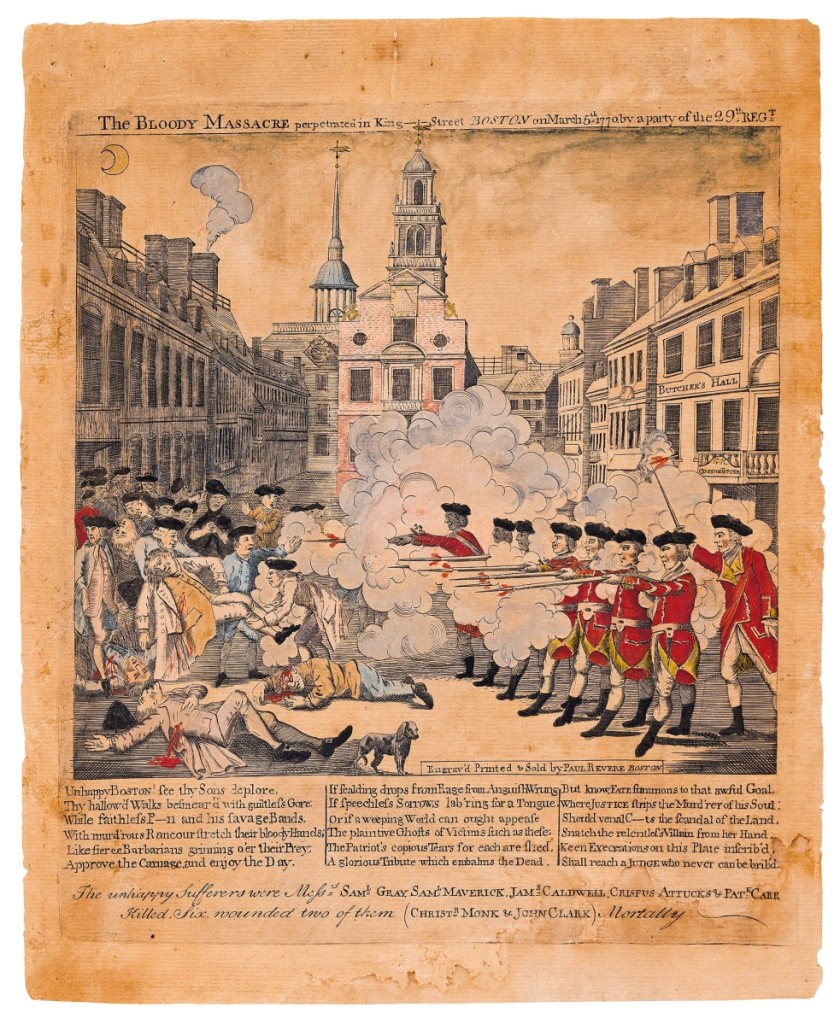
Highlighting the two-day sale was Paul Revere’s iconic 1770 engraving, “The Bloody Massacre,” which achieved $429,000 — a world auction record for the print. Property from the collection of New York advertising executive Monroe F. Dreher, the hand colored rendering of the Boston Massacre of March 5, 1770, during which the British killed five Bostonians, is Revere’s most well-known and sought-after print.
Auction Action In New York City
NEW YORK CITY – Doyle conducted a highly successful auction of American paintings and prints on November 2. Highlighting the sale was Paul Revere’s iconic 1770 engraving, “The Bloody Massacre,” which achieved $429,000 – a world auction record for the print. Also featured in the sale were Nineteenth and Twentieth Century paintings, and it was followed on November 3 by equally successful sales of American furniture, silver and decorative arts, plus objects of the Pacific Trade.
With competitive bidding, the November 2 sale totaled $1,384,891, far surpassing the estimate of $619,800/953,250, with 90 percent sold by lot and 99 percent sold by value. American furniture, silver, decorative arts and Pacific Trade on November 3 totaled $994,494, surpassing the estimate of $590,350/908,150, with 90 percent sold by lot and 100 percent sold by value.
Property from the collection of New York advertising executive Monroe F. Dreher, the hand colored engraving of “The Bloody Massacre” is Revere’s most well-known and sought-after print. This powerful rendering of the Boston Massacre of March 5, 1770, during which the British killed five Bostonians, is arguably the most famous propaganda image printed during the American Revolution. Immediately after the confrontation, Revere realized its significance at a time when tensions were high between England and the colonies, and he both sought to and succeeded in circulating a depiction that would further the patriots’ cause.
Also from the Dreher collection was Amos Doolittle’s (1754-1832) “A Display of the United States of America,” a 1794 hand colored engraving from the fourth state of five, published by the artist, New Haven, Conn., framed, 20¾ by 17 inches. Monroe Dreher had purchased it from the Old Print Shop in New York City in 1948. In the sale it brought $15,000.
Featured along with the Revere and Doolittle engravings on November 2 were Nineteenth and Twentieth Century paintings, including examples of portraiture; Hudson River, Western and regional landscapes; and still lifes, as well as Audubon, Currier & Ives and topographical prints. Special sections of the sale were devoted to marine paintings and Outsider art.
Determined bidders drove a landscape by Fidelia Bridges (1834-1923) soaring over its estimate of $3/5,000 to $93,750. “Small Bird with Flowering Ironweed” reflects Bridges’ expertise in depictions of birds and flowers in natural settings. She began her career working in oil, as in this painting, later gaining a reputation for her works in watercolor.
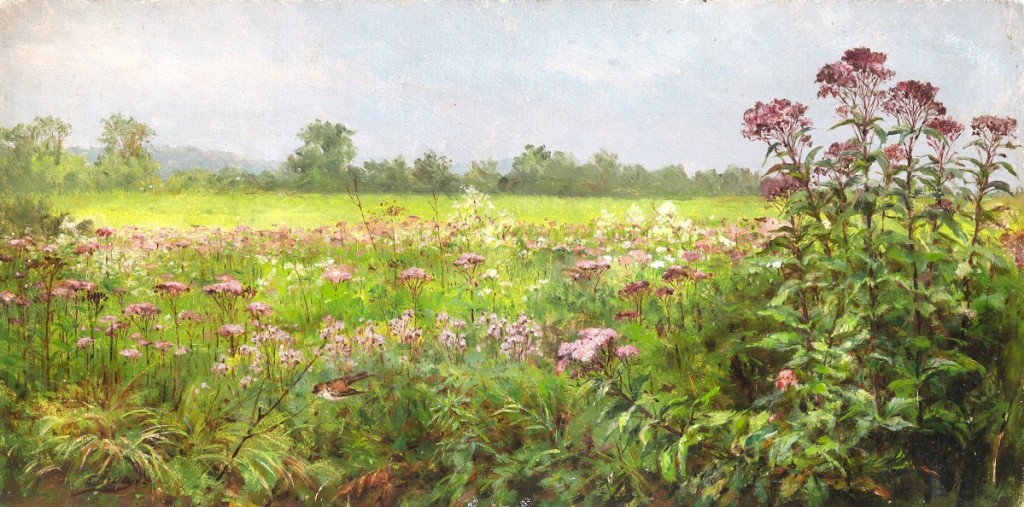
This landscape by Fidelia Bridges (1834-1923) “Small Bird with Flowering Ironweed,” was chased by determined bidders, soaring over its estimate of $3/5,000 to $93,750.
Topping the section of the sale devoted to marine paintings was a masterful view of a “Whaling Ship and Iceberg” from 1880 by William Bradford (1823-1892) that realized $93,750, surpassing its estimate of $60/90,000. The work highlighted the group of marine paintings from a prominent corporate collection. Strong prices were also realized for additional works from the same collection, including ship portraits by Antonio Jacobsen and Frederick Pansing that surpassed expectations.
Audubon prints in the sale featured “Fish Hawk,” 1830, from The Birds of America, that flew past its estimate of $30/50,000 to realize $81,250, one of the strongest prices for the print in recent years. Another print, this one after John James Audubon (1785-1851) was titled “Night Heron Or Qua Bird.” The hand colored etching, engraving and aquatint by R. Havell, 1835, on J. Whatman watermarked paper dated 1836, plate CCXXXVI from The Birds of America, was estimated $6/8,000 but did much better, finishing at $21,250.
Fetching $22,500 against its $5/7,000 estimate was Arthur Fitzwilliam Tait’s (American, 1819-1905) “Spring: The Mothers,” 1895, a portrait of barnyard ewes and their offspring. The 18-by-27-1/8-inch oil on canvas was signed A.F. Tait. N.A. and dated N.Y. 95 lower right.
A George Inness Jr (American, 1854-1926) landscape that had descended in the artist’s family sold for $21,420. The oil on board measured 57¾ by 41¾ inches.
Albert Bierstadt’s (American, 1830-1902) oil on canvas, “Valley of the Po,” 1857, was exhibited on long-term loan at the Saint Louis Art Museum from 2012 to 2020. It was signed with conjoined initials ABierstadt and dated Rome 1857 lower right. At 28¼ by 44 inches, it was bid to $18,900.
Thomas Sully (American, 1783-1872) painted the portrait of Evalina Thompson Dannenberg (1791-1816) in October/November 1815, in Philadelphia. The oil on canvas, 30-1/8 by 25 inches, which descended in the family of the sitter, fetched $13,750. Her husband, Christian Dannenberg, was a wine merchant, according to the Philadelphia Directory of 1816. The Dannenbergs were married on June 5, 1809, by Rt. Rev. Dr White, Rector at Christ Church in Philadelphia. Evalina Dannenberg passed away on July 8, 1816, and is interred in the burial grounds at Christ Church, Philadelphia.
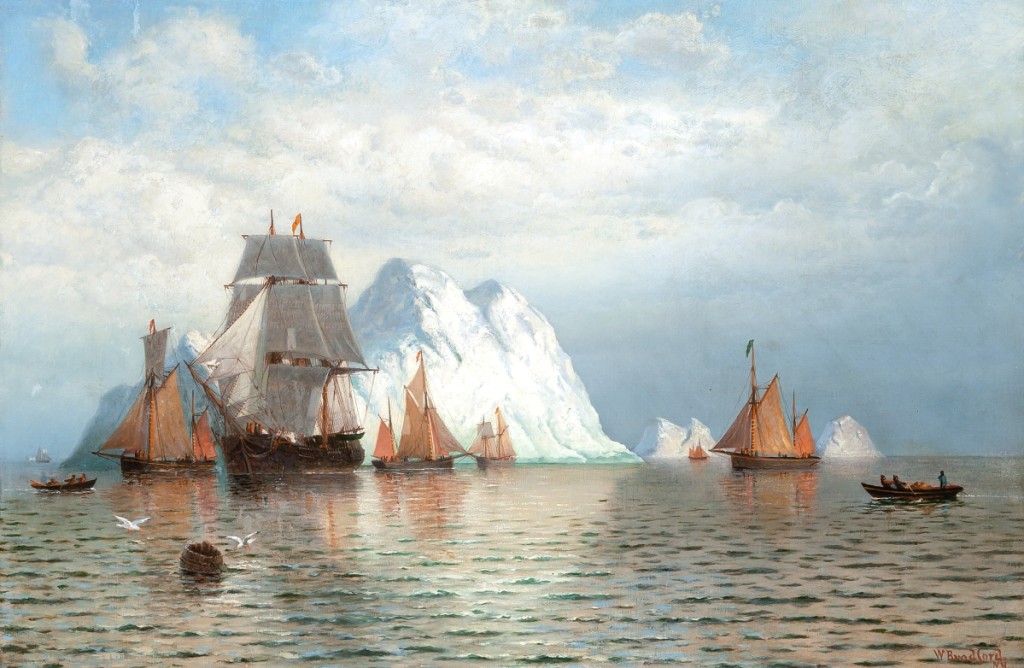
Topping the section of the sale devoted to marine paintings was William Bradford’s (1823-1892) masterful view of a “Whaling Ship and Iceberg” from 1880 that realized $93,750, surpassing its estimate of $60/90,000.
Bill Traylor’s (1854-1947) watercolor and graphite depiction of a “Black Panther” highlighted the selection of Outsider art offered in the sale. Property from the estate of an Upper West Side collector, the work surpassed its $25/35,000, selling for $40,950. Strong prices were also achieved for other works from the same estate. “Dahlia,” a wood relief by Ulysses Davis (1913-1990) tripled its $6/8,000 estimate, selling for $21,420, and a 1987 enamel on board by Bessie Harvey (b 1929) titled “Spirits” achieved $5,355, many times its $700-$1,000 estimate.
Property from a Scarsdale, N.Y., residence featured a colorful 1991 enamel on panel by Howard Finster (1916-2001) depicting a fantastical “Dostrolo – City in Visions of Other Worlds,” which realized $4,095, well over its $2/3,000 estimate.
The November 3 sale showcased American furniture and decorative arts, including silver, ceramics, mirrors, folk art, samplers and rugs. A special section of the auction was devoted to porcelain, paintings, decorative arts and other objects of the Pacific Trade.
Highlighting the sale was a group of rare Paul Revere silver from the Monroe and Elizabeth Dreher collection. The five examples attracted spirited bidding that drove the collection far over its total estimate of $73/105,000 to achieve $170,100. The top selling lot was an example of Revere’s “Liverpool” pitcher from 1805 that soared past its estimate of $25/35,000 to realize $94,500, and a Paul Revere Jr silver cream jug, Boston, 1783, took $22,680. With an inverted pear form on circular foot with beaded borders and double scroll handle, it was engraved with monogram SDS within foliate surround and stood 5 inches high.
This exceptional collection of Paul Revere silver and engraving was assembled by New York advertising executive Monroe F. Dreher (1889-1970), and the majority of the pieces have remained unseen for nearly 70 years. Many of the works had descended within the original families and Dreher was fastidious about recording the provenance of these pieces. Like many passionate collectors of American antiques in the 1940s and 1950s, Dreher outfitted his Connecticut residence as near period rooms. The collection was featured in The Magazine Antiques in 1954.
The sale also saw strong bidding and robust prices for American tall case clocks. A Federal inlaid mahogany musical tall case clock from New England sold for $22,680, many times its estimate of $2/4,000. Property from a Connecticut estate, this clever clock had six tunes in its repertoire. A circa 1770 Chippendale mahogany tall case clock by Joseph Ellicot of Buckingham, Penn., realized $13,860, tripling its $3/4,000 estimate.
From the private collection of Jacob and Sylvia Levy was a Philadelphia Chippendale mahogany side chair that attracted the attention of determined bidders who sent the chair sailing past its estimate of $600/900 to achieve $11,970. From the same collection were groups of pewter articles that performed exceptionally well, selling for $16,380.
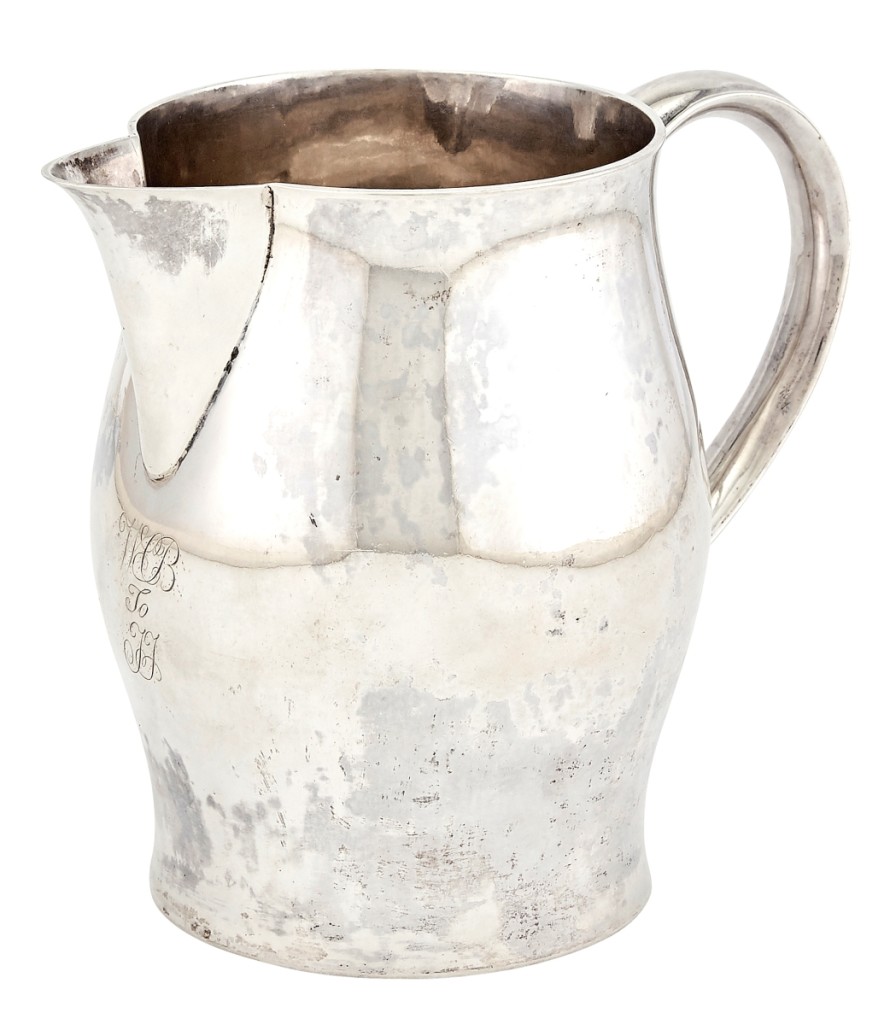
The November 3 sale showcased American furniture and decorative arts, including silver. Highlighting the sale was a group of rare Paul Revere silver from the Monroe and Elizabeth Dreher collection. Among the five examples that attracted spirited bidding was an example of Revere’s “Liverpool” pitcher from 1805 that soared past its estimate of $25/35,000 to realize $94,500.
A Queen Anne walnut dressing table from the Delaware Valley, mid-Eighteenth Century, brought $9,450. It featured shell carvings to apron and knees with a height of 29¾ inches, width of 33 inches and depth of 19½ inches.
Attributed to Thomas V. Brooks (1828-1895), New York and Chicago, 1860-80, was a carved and polychrome painted tobacconist “Indian Warrior” trade figure, 6 feet high, which came from a Southport, Conn., estate and earned $40,950. Brooks apprenticed under John Cromwell (1805-1873) beginning in 1841 to learn the art of ship and trade figure carving. The monumental trade figures by Brooks are often seen supporting their weight leaning on stumps, such as this example. After working on South Street downtown, Brooks moved to Chicago where he continued to work for several decades selling to buyers throughout the United States.
The Pacific Trade section attracted robust international bidding on Chinese export porcelain, paintings and decorative arts, Japanese and Southeast Asian art and more. Highlighting the offerings was a rare set of Nineteenth Century China Trade ornithological paintings that realized $10,710. Mounted in églomisé frames, the paintings depicted in ink and color various species of birds among flowers and foliage.
Chinese export porcelain featured a late Eighteenth Century porcelain punch bowl colorfully enameled with scenes of the Eighteen Luohan (original followers of the Buddha). Property from the Hallenbeck family collection, the bowl sold for $9,450, near the high end of its $7/10,000 estimate.
A large assortment of Eighteenth Century Chinese grisaille decorated export porcelain articles comprised 14 covered and/or handled articles, including teapoys, teapots and creamers; 16 cups and bowls; and eight saucers.
Property of a private New Jersey collector, the group outperformed its $800-$1,200 estimate to finish at $9,450.
And from a New York collection came a Jules-Emile Saintin (French, 1829-1894) “Portrait of a Young Chinese Man” that realized $5,985. The oil on canvas, 8¾ by 6½ inches, was signed “Jules E. Saintin, New York 1860” and had a dedication to Alexandre Dumas.
Prices given include the buyer’s premium as stated by the auction house. For information, www.doyle.com or 212-427-2730

























